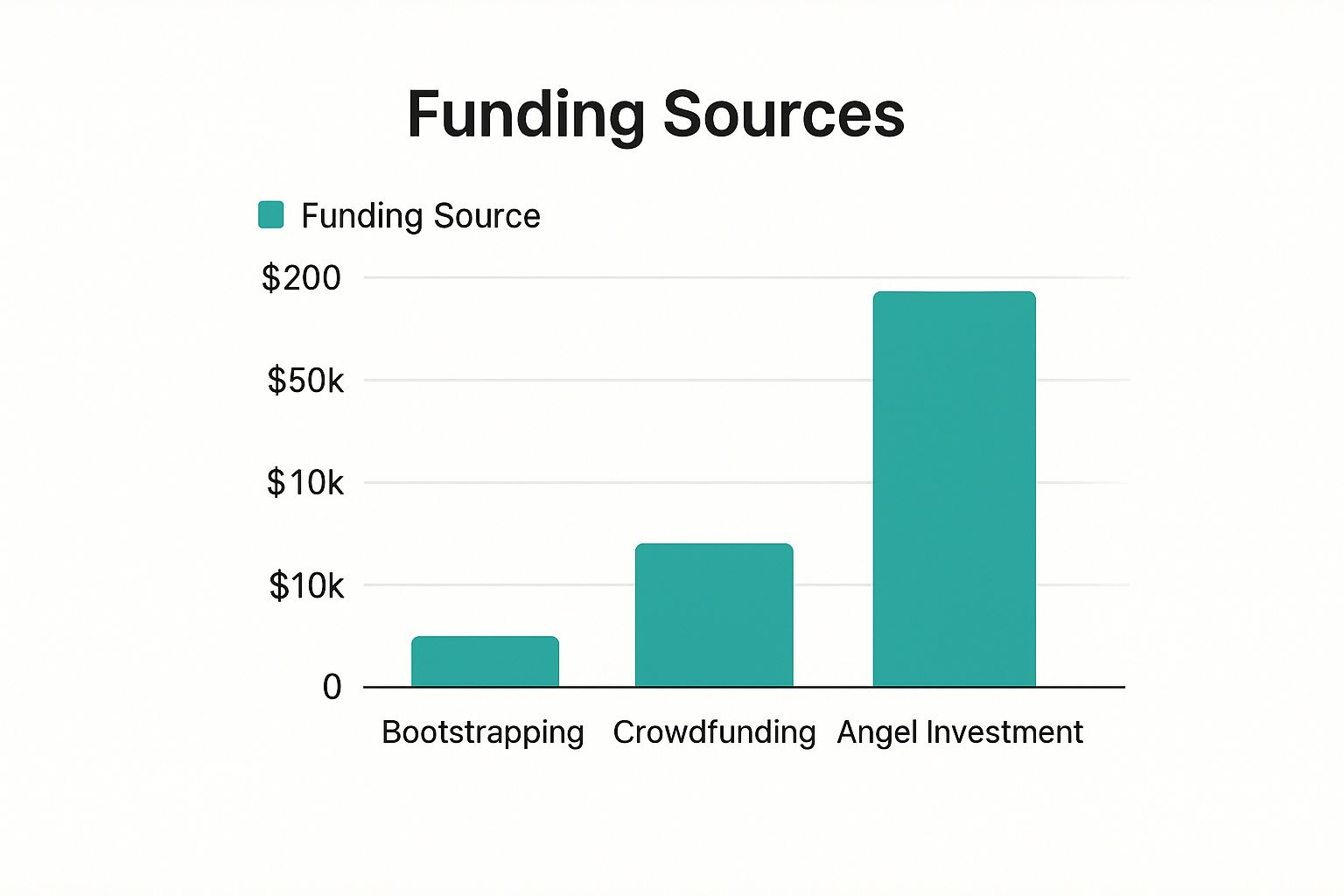Navigating Today's Startup Funding Landscape

Securing funding for your startup demands a keen understanding of the current investment climate. This environment is constantly in flux, making it crucial to understand the trends and adapt your approach for success. This section explores the current dynamics of startup funding to help you position your startup effectively.
Key Sectors and Funding Trends
Some sectors consistently attract more investment. Currently, fintech, healthcare, industrial technology, and IT are seeing significant investor interest. While other sectors still receive funding, understanding these trends can inform your overall strategy.
If your startup operates in a high-activity sector, connecting with investors might be easier. However, you'll also face increased competition. This makes a strong and differentiated value proposition essential.
The number of startup funding rounds has seen some volatility. As of Q1 2025, corporate-backed startup funding rounds hit 1,215, the highest quarterly total since 2022. This represents a 29% year-over-year increase.
Interestingly, the total value of global startup ecosystems has declined for the first time in five years due to fewer major exits and IPOs. While more companies are getting funded, overall valuations are experiencing downward pressure. You can find more detailed statistics here: Startup Genome Report 2025
The Psychology of Investors
Understanding investor motivations and concerns is essential. Currently, investors prioritize startups with strong fundamentals.
Here's what they're looking for:
- Clear paths to profitability
- Experienced teams
- Proven traction
Demonstrating market validation and a sustainable business model is more important than ever. Speculative ventures with uncertain futures are less appealing in the current climate.
Adapting Your Approach to Funding
Founders must be adaptable and resourceful in their pursuit of capital. Explore a range of funding options beyond traditional venture capital.
Consider these options:
- Bootstrapping in the early stages
- Leveraging your network for angel investments
- Exploring alternative funding paths like revenue-based financing
Crafting a compelling, data-driven pitch that resonates with current investor priorities is critical. By understanding the dynamics of today's startup funding landscape and adapting your strategy accordingly, you can significantly increase your chances of success.
Bootstrapping: Building Your Funding Foundation

While exploring external funding is essential, many thriving startups begin by bootstrapping. This means using personal savings, revenue, or a blend of both to fund the business. Bootstrapping creates a strong base, giving you invaluable learning experiences and more control. This section explores the pros and cons of bootstrapping to help you decide if it's right for your startup.
Extending Your Runway Through Smart Resource Management
Bootstrapping often means getting the most out of limited resources. This involves carefully controlling expenses and finding innovative ways to stretch your runway, the time your startup can operate before needing more funds.
One key strategy is focusing on crucial expenses, specifically those related to product development and attracting those first customers. For example, think about working from a co-working space or a home office rather than renting a large office space in the beginning.
Identifying Early Revenue Opportunities
Generating revenue early is crucial for bootstrapping success. This might involve pre-selling products, offering early-bird discounts, or providing creative services related to your core product.
This early revenue doesn't just extend your runway; it also validates your product or service in the market. It proves that people are willing to pay for what you're offering.
Balancing Personal and Business Finances
Bootstrapping often requires founders to invest their own money. This means finding a balance between personal financial well-being and business investment. It’s important to set realistic financial boundaries and avoid overextending yourself.
Creating clear financial milestones and having a personal budget are helpful tools. These can help you maintain a healthy balance and protect your personal finances.
Understanding the available funding options is essential. Consider reputable business loan companies. However, remember loans add financial pressure. Carefully consider them and have a solid repayment strategy in place.
The Allure of Bootstrapping for Future Investors
Successfully bootstrapping can make your business more appealing to future investors. It demonstrates financial discipline, resourcefulness, and dedication. It shows you can achieve significant progress with limited resources, indicating strong growth potential with added investment.
This foundation built through bootstrapping can be a stepping stone to securing substantial funding rounds later.
Let's take a closer look at the advantages and disadvantages of bootstrapping in comparison to external funding. The following table summarizes key differences.
Bootstrapping Pros and Cons
This table outlines the advantages and disadvantages of bootstrapping a startup compared to seeking external funding.
| Aspect |
Bootstrapping |
External Funding |
| Control |
Founders retain full control |
Investors gain some control |
| Equity |
Founders retain full ownership |
Founders share ownership with investors |
| Financial Risk |
Lower initial financial risk |
Higher initial financial risk due to debt or equity obligations |
| Growth Potential |
Slower initial growth |
Faster potential growth with access to capital |
| Learning Curve |
Steep learning curve in all aspects of the business |
Can rely on investor expertise and network |
| Financial Discipline |
Enforces financial discipline |
May lead to less stringent financial practices |
| Long-Term Value |
Can build long-term value by retaining ownership |
May dilute long-term value by sharing ownership |
| Time Commitment |
Often requires significant time investment from founders |
Can delegate some responsibilities to hired personnel |
This comparison highlights the trade-offs between control and growth. Bootstrapping offers greater control but may limit initial growth. External funding can accelerate growth but requires sharing ownership and control. Choosing the right path depends on your specific circumstances and long-term goals.
Early Capital: Friends, Family, and Angel Investors

Securing initial funding for a startup often relies on personal networks. This section explores navigating these early funding sources – friends, family, and angel investors – to build a solid financial foundation.
Tapping Into Your Network: Friends and Family
Approaching friends and family for investment requires delicate handling. These relationships are valuable, and preserving them is crucial. Open communication and a professional approach are essential for success.
Transparency is key: Clearly outline the inherent risks, the potential for financial loss, and a realistic timeline for any returns. Setting clear expectations from the outset helps avoid misunderstandings down the road.
Formal agreements are essential: Treat these investments with the same formality as any other investor relationship. A simple, written agreement outlining the terms protects both parties and fosters a professional dynamic.
Regular updates build trust: Consistent communication about progress, challenges, and milestones reinforces trust and keeps everyone informed. This transparency demonstrates respect for their investment.
Imagine presenting your business plan to your family just as you would to potential investors at a venture capital firm. Answering their questions thoroughly and honestly showcases your seriousness and commitment.
Entering the Angel Investor Realm
Angel investors are individuals who provide capital for startups, often in exchange for equity. They bring not only financial resources but also valuable experience and network connections. Finding the right angel investors can significantly impact early-stage success.
Look beyond just the financial contribution. Seek investors who share your vision and demonstrate a genuine interest in your industry. Their expertise and network can be invaluable assets.
Networking is crucial: Attend industry events, engage in online communities, and leverage your existing network to connect with potential angel investors. Building relationships within your industry increases your chances of finding the right fit.
A compelling pitch deck is essential: A concise and visually engaging pitch deck highlights your business idea, market opportunity, and team expertise. Clearly communicate your value proposition and the potential return on investment.
Understanding their motivations: While financial returns are important, angel investors are often driven by factors beyond profit. Highlighting aspects like supporting innovation or contributing to industry growth can resonate strongly.
Tailor your pitch to align with the investor's individual interests. If an investor has a history of supporting sustainable businesses, emphasize this aspect of your startup if applicable.
Structuring Early-Stage Investments
Structuring these early investments correctly is critical to avoid future complications. This involves creating clear agreements that outline the terms, including equity ownership, decision-making power, and potential exit strategies.
Consider using convertible notes or SAFE (Simple Agreement for Future Equity) agreements. These instruments simplify the early stages and offer flexibility. They postpone complex valuation discussions until a later funding round.
Consulting with legal counsel specializing in startup funding is highly recommended. They can navigate the complexities of these agreements, ensuring both your and your investor's interests are protected. This establishes a solid legal foundation for your startup's future.
Cracking the Venture Capital Code
Venture capital remains a powerful funding option for startups, but the process can seem complex. This section breaks down the venture capital journey, sharing insights from both venture capitalists (VCs) and founders who have successfully navigated the process.

The infographic above illustrates potential funding amounts from various early-stage sources. Bootstrapping typically yields smaller amounts, crowdfunding offers a moderate level, and angel investments can reach significantly higher figures. Each option caters to the diverse needs of startups at different growth stages.
Identifying The Right VC Partners
Securing venture capital isn't solely about the money. It's about finding the right partners who will support your startup's journey. Successful startups seek VCs who share their vision, possess relevant industry expertise, and provide strategic guidance beyond the financial investment. This long-term perspective is essential for sustainable growth.
For instance, a sustainable agriculture startup would benefit more from a specialized VC in that field than a generalist. The specialized VC's knowledge and network can provide invaluable support in navigating market-specific challenges and opportunities.
Warm Introductions That Open Doors
Gaining access to VCs often requires warm introductions. However, not all introductions are equal. A generic email from a distant connection is unlikely to be effective. The best introductions come from individuals who can genuinely vouch for your startup and its potential, such as a trusted advisor, a respected mentor, or even a satisfied early customer. Their endorsement adds weight and credibility, increasing the likelihood of your pitch receiving serious consideration.
Navigating The Due Diligence Process
Once you've piqued a VC's interest, the due diligence process begins. This is a thorough investigation of your startup's financials, team, market, and overall potential. This crucial stage can significantly impact your funding prospects.
Transparency and preparedness are essential. Organized financial records, a clear business plan, and a well-defined market strategy build investor confidence. These demonstrate that you're building a sustainable business, not just a product.
Speaking of the funding landscape, the rise of unicorns—startups valued at $1 billion or more—has greatly influenced the startup world. As of February 2025, over 1,200 such companies existed globally, tripling the 2019 figure. Learn more about startup statistics. However, this growth has slowed, indicating a more challenging investment climate.
The following table provides a breakdown of different VC funding stages:
Venture Capital Funding Stages
| Funding Stage |
Typical Amount |
Company Stage |
Investor Expectations |
| Seed |
$100K - $2M |
Idea/Prototype |
Strong team, large market potential |
| Series A |
$2M - $15M |
Early traction, product-market fit |
Scalable business model, proven team |
| Series B |
$15M - $50M |
Expansion stage, growing revenue |
Market leadership potential, strong management team |
| Series C |
$50M+ |
Growth stage, established market presence |
Profitability, IPO potential |
This table outlines the different funding stages, typical investment amounts, and investor expectations at each stage, providing a helpful guide for navigating the VC landscape. Understanding these stages can significantly increase your chances of securing funding.
Pitching For Success: Addressing Unstated Concerns
Your pitch should address both the obvious questions and the unspoken concerns of investors. These often revolve around market competition, scalability, and the long-term viability of your business model.
Proactively addressing these concerns demonstrates foresight and a deep understanding of your industry, strengthening your position and increasing your chances of securing funding.
Negotiation Strategies That Protect Your Interests
Negotiating with VCs requires a careful balance. You aim to secure favorable terms while maintaining a positive relationship with potential partners. This involves knowing your worth, understanding your non-negotiables, and being prepared to walk away if the deal isn't right for your startup.
A well-structured deal protects your interests and ensures a productive partnership that benefits both parties, setting the stage for a successful and mutually beneficial relationship. Securing venture capital is not just about funding; it's about building a strategic partnership that can drive your startup's long-term success.
Beyond VC: Alternative Funding Paths That Actually Work
Venture capital often dominates conversations about startup funding. But it's not the only path, and often not the best fit. Savvy founders explore other avenues aligned with their specific needs. This section explores some of these alternatives, offering a broader perspective on startup funding.
Revenue-Based Financing: Fueling Growth With Future Earnings
Revenue-based financing lets startups secure funding in exchange for a percentage of future revenue. This model offers several benefits over traditional equity-based funding. Founders retain more ownership and control. Repayments fluctuate with revenue, lessening the burden during lean times.
This flexibility makes revenue-based financing particularly appealing to businesses with predictable income. It allows them to access capital without sacrificing significant equity or facing rigid repayment schedules.
Equity Crowdfunding: Tapping Into The Power of The Crowd
Equity crowdfunding platforms provide a viable option for startups seeking capital. They allow you to raise funds from many individual investors, each contributing smaller amounts. This approach not only secures capital but also builds a community.
These platforms connect founders with potential backers passionate about their ideas. Kickstarter and Indiegogo are prime examples of platforms enabling startups to share their stories and connect with potential investors.
Funding for startups isn't limited to venture capital. In March 2025, some large global startup funding rounds included $200 million for Lila Sciences, $240 million for Shield AI, and $250 million each for Celestial AI and Epirus. These diverse sectors, with AI-driven innovation prominent, demonstrate the breadth of investment opportunities. There are over 150 million startups worldwide, with about 50 million new ventures launched annually. Learn more: Global Startup Funding Trends.
Accelerators and Incubators: More Than Just Money
Accelerators and incubators offer more than just funding. They provide mentorship, resources, and a network of experienced entrepreneurs and investors. These programs can be essential for early-stage companies.
Guidance and support are key to navigating the complexities of building a business. Y Combinator and Techstars are prominent examples of accelerator programs that have helped launch many successful startups.
Strategic Corporate Partnerships: Leveraging Synergy and Resources
Strategic partnerships with established corporations can be beneficial. They offer startups access to capital, distribution channels, and valuable expertise. These partnerships can be mutually beneficial.
Larger companies can tap into the innovation of startups. Emerging businesses gain the resources they need to scale. This strategy works well for startups in industries aligned with the corporation's core business.
Government Grants and Customer Pre-Financing: Exploring Untapped Resources
Many startups overlook government grants and customer pre-financing. Government grants provide non-dilutive funding for businesses working on innovative projects aligned with policy goals. Customer pre-financing involves securing funds from customers before product launch.
This early revenue provides valuable validation. It demonstrates product-market fit and builds early customer relationships, setting the stage for future growth.
Finding the Right Funding Mix
Each funding path has its own advantages and disadvantages. Carefully consider your startup's stage, growth trajectory, and long-term goals. The ideal approach may involve a combination of funding sources.
Finding the right mix is crucial. It should align with your vision, preserve your control, and maximize your growth potential. IndieMerger can be a valuable resource for solo founders seeking a co-founder to improve their funding prospects.
Crafting Pitches That Actually Get Funded
Even groundbreaking startups can fail to secure funding if their pitches are weak. This section explores how to create presentations that truly resonate with investors, moving beyond generic advice to offer practical, evidence-based strategies.
Structuring Your Story for Maximum Impact
A compelling narrative is essential. Your pitch should tell a clear, concise story about your startup. This includes identifying the problem you're solving, presenting your solution, and showcasing the market opportunity. Clearly articulate how your startup differs from the competition and why your team is the right one to execute this vision.
Think of your pitch as a movie trailer, highlighting the most exciting aspects of your story and leaving investors wanting more. Focus on a key customer success story or a significant milestone you've achieved.
Presenting Financials That Build Confidence
Financial projections are crucial. Present these numbers clearly and realistically. Focus on data-backed projections that demonstrate a solid understanding of your business model rather than overly optimistic, unsupported forecasts. Include key metrics such as customer acquisition cost, lifetime value, and projected revenue growth.
Present your financials as a story about growth and potential, not just a series of numbers. Explain the reasoning behind your projections to build trust and credibility with investors.
Addressing Potential Objections Proactively
Anticipating investor concerns is key. By proactively addressing potential objections about market competition, scalability, or financial risks, you demonstrate thorough preparation and a deep understanding of your business. This shows you're not only aware of the challenges, but you've also thought about how to overcome them.
Think of investor objections as opportunities. By providing thoughtful responses, you address concerns and highlight the robustness of your business.
Tailoring Your Presentation for Different Audiences
Different investors have different priorities. A pitch tailored for an angel investor will differ from one designed for a venture capital firm. Understanding your audience is crucial. Research their investment history and align your pitch with their specific interests.
Adjust your presentation format based on the setting. A quick elevator pitch needs a concise, impactful message, while a board presentation requires more detailed information and financial analysis. This adaptability demonstrates professionalism.
Mastering the Art of Delivery
Confident body language, clear communication, and the ability to handle tough questions are essential. Practice your delivery thoroughly. Be prepared to answer difficult questions without becoming defensive. Your composure and knowledge will instill confidence in potential investors.
Remember, your passion is contagious. Let your enthusiasm for your startup shine through. Passion and conviction can be as compelling as the data you present.
Following Up Strategically
Following up after your pitch is essential. A personalized thank-you note reiterating key takeaways from the meeting, followed by a concise summary of next steps, can maintain momentum.
Consider this follow-up an extension of your pitch. It’s another chance to reinforce your key messages and further engage potential investors.
Are you a solo founder looking to strengthen your startup and attract funding? IndieMerger connects you with verified co-founders to enhance your team, accelerate growth, and make your business more appealing to investors. Visit IndieMerger today to find your perfect match.